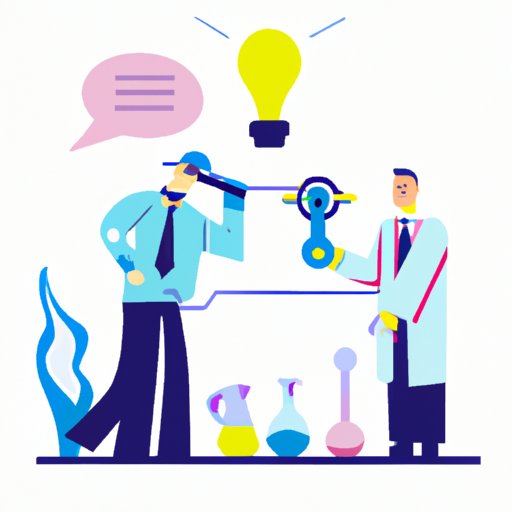Introduction
Collaboration and communication are essential components of successful scientific research. Collaboration involves working together with other scientists to advance scientific knowledge, while communication is the process of exchanging information and ideas between scientists. In today’s fast-paced world, collaboration and communication are increasingly important in the field of science as they enable researchers to effectively share data, generate new ideas, and create innovative solutions.

Exploring the Role of Collaboration and Communication in Advancing Scientific Research
Collaboration and communication play a critical role in advancing scientific research. By working together, scientists can pool their resources and expertise to tackle complex problems and develop more effective solutions. According to a study conducted by the National Institutes of Health, “collaborative research projects are more likely to result in larger grants, more publications, and greater visibility than individual efforts.”
Examples of successful collaborations in science include the Human Genome Project and the International Space Station. The Human Genome Project was an international effort to map the entire human genome. Through collaboration, scientists were able to identify and sequence all of the genes in the human genome, paving the way for breakthroughs in genetics and biotechnology. Similarly, the International Space Station was the result of a collaboration between the United States, Russia, Europe, Japan, and Canada. This project enabled scientists to conduct experiments in space and gain a better understanding of the universe.
Examining the Benefits of Collaboration and Communication in the Scientific Community
Collaboration and communication offer many benefits to the scientific community. By collaborating and communicating, scientists can strengthen relationships among peers, share resources and ideas, and enhance knowledge sharing. These activities not only promote scientific progress, but also foster a sense of camaraderie and community within the scientific field.
For example, scientists who collaborate and communicate regularly often develop stronger relationships with their colleagues. This allows them to exchange ideas and perspectives more easily, which can lead to more creative solutions and better results. Additionally, collaboration and communication enable scientists to share resources that may otherwise be difficult to obtain on their own. As a result, scientists can access a wider range of data and materials that can help them make more informed decisions.
Finally, collaboration and communication also facilitate knowledge sharing. By discussing their findings with other scientists, researchers can gain insight into areas of research that they may not have considered before. This can lead to new discoveries and breakthroughs that have the potential to revolutionize the scientific field.
Understanding How Collaboration and Communication Enhance Science Education
Collaboration and communication are also essential for enhancing science education. By working together in teams, students are encouraged to engage in meaningful dialogue and exchange ideas. This type of collaborative learning environment helps students gain a deeper understanding of scientific concepts and encourages them to think critically about the material.
In addition, collaboration and communication can help bridge the gap between students and teachers. By engaging in open dialogue, teachers can better understand the needs of their students and tailor their lessons accordingly. Likewise, students can ask questions and receive feedback from their instructors, allowing them to gain a more comprehensive understanding of the material.
Finally, collaboration and communication can help foster a sense of community among students. By working together, students can learn from each other, build relationships, and develop a stronger appreciation for the scientific field.

The Impact of Collaboration and Communication on Scientific Innovation
Collaboration and communication also play a key role in scientific innovation. By working together, scientists can combine their expertise and insights to solve complex problems more quickly and efficiently. This type of collaboration enables scientists to think outside the box and come up with innovative solutions that have the potential to revolutionize the scientific field.
Furthermore, collaboration and communication can lead to improved problem solving. By exchanging ideas and perspectives, scientists can gain a better understanding of the issue at hand and develop more effective strategies for addressing it. Additionally, collaboration and communication can help foster creativity and encourage scientists to explore new approaches and possibilities.
Finally, collaboration and communication can accelerate technological advancement. By sharing data and resources, scientists can speed up the development of new technologies and products. This can lead to major breakthroughs in a variety of fields, from medicine to energy production.

Discussing the Challenges of Collaboration and Communication in the Scientific Field
Despite the numerous benefits of collaboration and communication, there are still some challenges associated with these activities in the scientific field. One of the most common challenges is language barriers. Because scientists from different countries often collaborate on projects, language differences can make it difficult for them to effectively communicate and exchange ideas.
Additionally, coordinating different research teams can be challenging. Without proper coordination, teams may find it difficult to work together efficiently and effectively. Furthermore, inadequate funding can be a major obstacle to collaboration and communication in the scientific field. Without adequate resources, teams may struggle to complete their projects.
Conclusion
In conclusion, collaboration and communication are essential components of successful scientific research. They enable scientists to share data and resources, generate new ideas, and create innovative solutions. Additionally, collaboration and communication can strengthen relationships among scientists, facilitate the exchange of ideas, and enhance knowledge sharing. Finally, collaboration and communication can improve problem solving, increase creativity, and accelerate technological advancement. Despite these benefits, there are still some challenges associated with collaboration and communication in the scientific field, such as language barriers, difficulty coordinating different research teams, and inadequate funding. Overall, collaboration and communication are essential for advancing scientific research and promoting scientific progress.
(Note: Is this article not meeting your expectations? Do you have knowledge or insights to share? Unlock new opportunities and expand your reach by joining our authors team. Click Registration to join us and share your expertise with our readers.)
